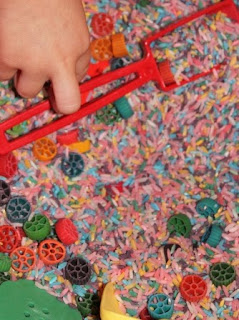However, sensory play and regulation is crucial in the classroom as well. I have seen students that were struggling with acting out find ways to calm themselves down and be a successful student again after engaging in sensory play. After working with many teachers on ideas for sensory experiences in their classroom, I thought that these things could also be set up at home. I have begun working with parents to set up sensory stations at home and educating them on the benefits of how to use them so their family is calmer and their child is more regulated.
Here are some of the most successful sensory stations that I have used:
Rice Tray
I choose to use rice instead of sand in the classroom or inside the home, because it is easier to clean up and it is cheap. I also prefer rice over beans because you can vary the color and it smells better. You will want to base your tray size from the age of your students. For a kindergarten classroom, I would probably use something similar to a shoe box. It is deep and small. For middle school or older, you could use something much larger and less deep. I then put various colored rocks, stones, and other objects in a bag next to the tray. I also have a rake, shovel, cup, etc. These allow for the child to explore in the rice tray, gaining the full sensory experience.
The location of the tray should be somewhere off from the rest of the class and in a quiet place. I found that most teachers like to keep it close to their desk so they can be near the student that is using it. What you don't want is a student that is disregulated trying to soothe and calm themselves down in the rice tray, and then being surrounded by a bunch of other loud students.
Here is a link on how to color rice: How to Color Rice
Scented Play Dough
This works great to help a hyper or energetic student to refocus. I had the teachers take small Ziploc bags with a small amount of scented play dough and keep them in their desk. Whenever they would notice a student getting off task or fidgety, they would hand them the play dough to use for 10 minutes. For older students, the teacher just left some out on her desk and the students would use it as needed.Here is a link to make your own: Scented Play Dough
Weighted Animals
These are simple to make. I just open up a stuffed animal (I try to find something shiny and unisex so the boys like it too) and add some beans, colored floral stones, or whatever I have around. I then stitch it back up. It's not always a pretty stitch, but that is usually part of the appeal to the kids. I have the teachers let a "special helper" get to carry the animal or care for the animal. I tell the teacher that a student who seems like they just need a hug or just need some time on their own is perfect for this "special helper." The added weight in the animal helps to provide a unique sensory experience that can re-center and regulate their body. This also worked great for students that had a hard time in line and with transitions during the day.Here is a link to buy weighted objects: Weighted blankets and animals
Music or Quiet Station
This is in a small corner of the classroom, or for older kids, could just be a portable cd player they can have at their desk. I include comfortable headphones, not the ones that go inside of the ear, a CD player, and a nature or relaxation cd. Sometimes the noise of the classroom, cafeteria, gym, or recess can be too much for some students, so having the soothing nature sounds can help them to regroup and get ready to participate in the classroom.There are many more sensory play activities that you can incorporate into your lesson plans and use if you find that your students are really benefiting from the extra sensory experiences. However, if you keep these few around your classroom and use them regularly, you should notice a decrease in outbursts and misbehavior.
For parents, if you have a child who seems to be struggling in the classroom, these are great things to suggest to your child's teacher. You could even make a small sensory kit for your child to take to school and use as needed.





No comments:
Post a Comment